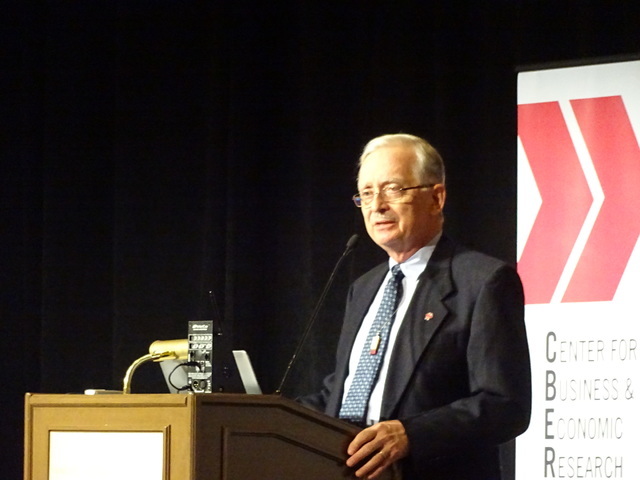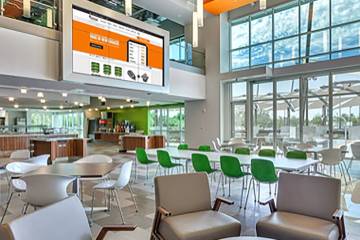
Twice in the same month, the state of the economy in Southern Nevada has come under the microscope in a forum staged for the local business community.
And while the numbers were close, those attending the UNLV Economic Outlook Update came away with a more guarded view of the future.
At the Las Vegas Global Economic Alliance Perspective June 16, Jeremy Aguero, principal at Applied Analysis, delivered the numbers with almost boastful energy, proud of the accomplishments of the community.
Stephen Miller, director of the UNLV Center for Business and Economic Research, delivered the same message with a more tepid and somewhat cautionary tone, driven by his concerns for the world economy and how it might affect the U.S. as a nation and Las Vegas as an international resort destination.
Key in Miller’s overview is the fact that while the U.S. economy continues to expand, it is a “much-subdued expansion.” The world’s economic growth is slowing.
China, according to Miller, has tremendous influence over emerging countries in Africa and South America. China’s housing market is teetering due to an excess in inventory that could cause that nation’s economy to suffer another recession. A China recession could slow the trade of goods around the world which could influence other economies.
Despite the Brexit controversy, Miller sees the European area as a “weak player” in the world of economic influence.
Miller stated that the U.S. is entering its eighth year of expansion following the recession and according to the Conference Board’s U.S. Leading Economic Index, there is “no signal of recession” at this time.
To demonstrate his confidence in the U.S. economy, Miller presented a series of charts tracking manufacturing, Treasury interest rates, and even the U.S. Policy Uncertainty Index combined with the consumer sentiment, which all pointed in a positive direction. He said employment is “relatively strong,” crude oil prices are remaining low, and the housing market is “a bit tight.”
Miller, like Aguero during his Perspective presentation, was quick to point out the positive fact that employment levels in Southern Nevada have nearly reached the pre-recession level despite the fact that there are 50,000 fewer construction workers. That means a more diversified employment economy in Southern Nevada.
Again, Miller was cautiously optimistic, stating that the “Nevada economy continues to expand” but added that this is a “subdued expansion.” Miller sees continued “employment growth in most sectors.”
One of the positive signs is that Nevada tied with Michigan for the number 12 position in employment growth since the end of the “Great Recession.” Nevada also tied for fifth place along with Idaho, South Carolina, Florida, and Rhode Island in unemployment rate reduction.
However, Nevada is not without its problem areas. Nevada ranks number 48 when it comes to the number of children in households headed by someone with less than a high school education.
When it comes to children without health insurance, Nevada ranks 47th with 10 percent of the children falling into this category.
While the number of negative or near negative equity mortgages in Nevada fell from 73 percent in the fourth quarter of 2009 to 22 percent in the third quarter of 2015, it is still one of the higher numbers in the U.S.
Miller finished his presentation with a number of charts showing upward trends in Clark County taxable sales and employment. Both the McCarran Passengers at 4 million and the Clark County visitor volume at 3.9 million are at near record-breaking levels despite the fact that Clark County hotel occupancy is at 87 percent, down from a prerecession high of close to 93 percent.
While gaming revenue is down from the prerecession peak of $1.05 billion, it is still rising from a recession low of $650 million to a current $850 million.
In the real estate sector, the office market vacancy rate has improved slightly from 26 percent down to 23 percent. Also showing a slight improvement is the retail market vacancy which has dropped from 11 percent to 9 percent. The most significant improvement came from the industrial market, which despite a large increase of constructed space, still managed to drop its vacancy rate from a high of nearly 17 percent down to a current 7 percent.
Miller summarized his guardedly positive outlook by pointing out the risks that could derail future economic progress. At the top of the list are “changes in the international growth” followed by U.S. monetary policy and its “schedule of interest rate changes.”
The final risk, which really does not have anything to do with the economics of the U.S. or any other country, is the threat of a terrorist event. Such an event could disrupt the U.S. economic growth and especially the growth of the Southern Nevada economy if it were to take place along the Strip or in the Fremont Street Experience.






